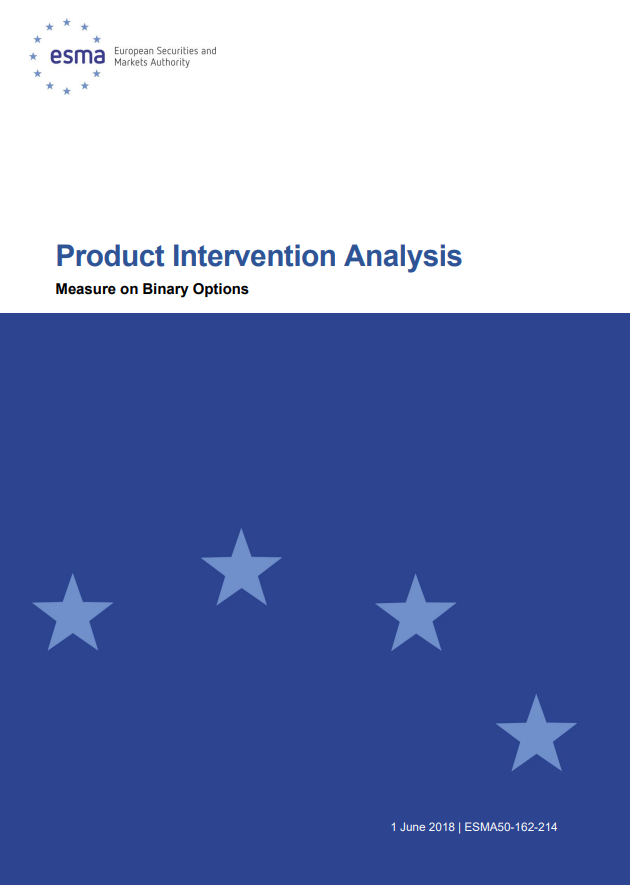Product Intervention Analysis Measure on Binary Options

1 Executive summary
This document summarises and analyses relevant evidence in relation to the provision of
binary options to retail clients. This document complements the European Securities and
Markets Authority Decision of 22 May 2018 to temporarily prohibit the marketing, distribution
or sale of binary options to retail clients in the Union in accordance with Article 40 of
Regulation (EU) No 600/2014 of the European Parliament and of the Council (the Decision),
providing additional detail. This document sets out:
(i) analysis of the impact that different intervention options in relation to binary
options would be expected to have on investors and on firms; and
(ii) a study of the properties of the distribution of returns from investing in binary
options.
In designing the product intervention measures through extended information-gathering and
discussion with National Competent Authorities (NCAs), ESMA considered different
alternatives. Section 2 of this document describes the different options considered and
examines the expected impact of each option. Some impacts are described solely in
qualitative terms, while in other cases quantitative information is available.
On 18 January 2018, ESMA issued a call for evidence on possible intervention measures,
to gather additional information. While most respondents to the call for evidence focused on
issues related to contracts for differences, a minority made reference to binary options.
Section 2 of this document takes these views into account.
Two fundamental features of the return distribution of binary options are especially relevant
from the perspective of possible intervention measures. These are (i) the high levels of risk
involved in binary options, and (ii) the negative expected return of the product. Section 3
examines these features in some detail. A key consequence of the second feature is that
the more often an individual invests in binary options, the more likely he or she is to suffer a
loss on a cumulative basis, and the more likely he or she is to exhaust a given amount of
money available for investing.
Binary options can be structured or provided in different ways. For example, some providers
quote continual two-way pricing, allowing an investor to sell back an option before expiry.
Section 3 sets out simulations based on some more standard products, using examples of
specific numerical payoffs. Importantly, however, the analytical results apply in all cases, as
demonstrated on theoretical grounds. Data presented in section 3 further corroborate the
broad applicability of the analysis. Other data indicate the pertinence of the results relating
to repeated trades.
2 Analysis of likely impact of different options
1. This section of the document:
describes what binary options are and describes the retail market for binary options;
explains the key features of the problem that has led ESMA to take action;
summarises the intervention measures that ESMA is introducing;
examines any potential impact the different intervention options could have on market
efficiency and the wider financial system; and
analyses the expected direct impact of the different intervention options on investors and
on firms.
2. More precise detail on what binary options are, the intervention measure and the problem
addressed are in the Decision alongside which this document is published.
2.1 Product description and overview of the retail market
2.1.1 Key product features
3. A binary option is a cash-settled derivative that expires at a pre-specified time. It generally has
two possible outcomes at expiry: either it pays out a fixed monetary amount (the “fixed payoff”),
specified in advance, or it is worth zero (i.e. the investor loses the entire investment). The option
pays out at expiry if a specified event relating to the price of the underlying has occurred. If, at
expiry, the specified event has occurred, the option is said to “finish in-the-money”.
4. Commonly, the specified event that determines whether a binary option pays out is whether the
price of the underlying at expiry exceeds the price of the underlying when the option was issued.
A binary option based on a specified event of this sort is sometimes called an “up-down” binary
option. Box 1 gives an example of an up-down binary option.




